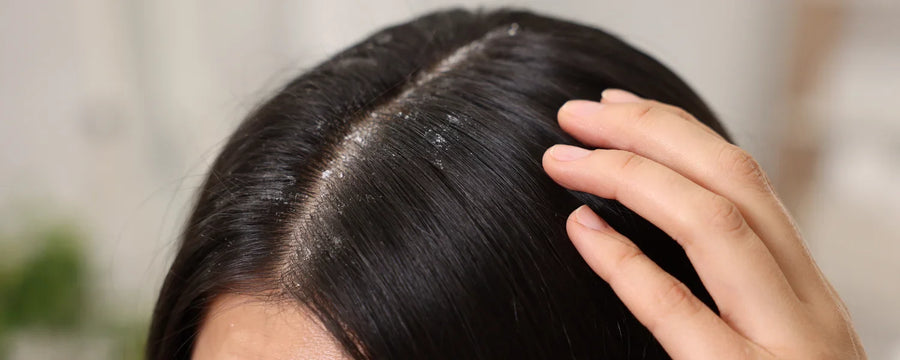

Read through by Dorthe Kristensen
Hairdresser and former co-owner of the award-winning hairdressing chain Zoom by Zoom
With many years of experience in the hairdressing industry, Dorthe has advised many customers about hair and hair care. Dorthe has read through this blog entry to ensure high quality and professionalism. This blog post is professionally updated on April 25, 2025.
Table of contents
Dandruff, a common scalp condition characterized by flaking and itchiness, affects millions of individuals globally. While many over-the-counter shampoos promise quick relief, they often contain harsh chemicals that can exacerbate the problem over time. As a result, more people are turning to natural alternatives like tea tree oil.
Tea tree oil is extracted from the leaves of the Melaleuca alternifolia plant, and is celebrated for its potent antifungal, antibacterial, and anti-inflammatory properties. This comprehensive guide explores its efficacy, application methods, and safety precautions to help you combat dandruff naturally and effectively.
Understanding dandruff and its causes
Dandruff is typically caused by the overgrowth of a yeast-like fungus known as Malassezia, which thrives on the natural oils secreted by the scalp. This overgrowth can irritate the scalp, leading to accelerated shedding of skin cells and the formation of visible flakes. Contributing factors may include excessive oil production, hormonal imbalances, stress, infrequent hair washing, and the use of unsuitable hair care products. Understanding these underlying causes is essential for effective treatment.
How effective is tea tree oil for treating dandruff?
One of tea tree oil's most powerful components is terpinen-4-ol, a compound widely recognized for its potent antimicrobial and anti-inflammatory effects. This naturally occurring element is instrumental in regulating the growth of Malassezia, a yeast-like fungus closely linked to the development of dandruff. By inhibiting the growth and spread of this microorganism, terpinen-4-ol helps restore a healthy balance to the scalp's microbiome, addressing one of the primary underlying causes of dandruff.
Moreover, those who integrate tea tree oil into their routine often notice long-term improvements in scalp health, including reduced recurrence of dandruff, enhanced comfort, and a fresher, cleaner scalp sensation. For those seeking a natural, scientifically-backed alternative to chemical-based treatments, tea tree oil represents a compelling and effective solution.
Proper dilution and application of tea tree oil
Due to its high concentration, tea tree oil should never be applied directly to the scalp without proper dilution, as doing so can lead to irritation, dryness, or even chemical burns in sensitive individuals. The skin on the scalp is delicate, and undiluted essential oils can disrupt its natural barrier.
How to dilute tea tree oil for dandruff
To safely and effectively use tea tree oil for dandruff, it is essential to dilute it with a carrier oil. A commonly recommended ratio is 2 to 3 drops of tea tree oil per tablespoon of a suitable carrier oil. Options include coconut oil, avocado oil, jojoba oil, or olive oil. These carrier oils not only help reduce the concentration of the tea tree oil—minimizing the risk of irritation—but also provide added benefits such as deep hydration and additional antimicrobial support, enhancing the overall effectiveness of the treatment for scalp health and dandruff reduction.
How to apply tea tree oil for dandruff
Once the mixture is prepared, it should be gently massaged into the scalp using circular motions to stimulate blood circulation and enhance absorption. Allow the blend to sit on the scalp for 15 to 30 minutes to give the active compounds sufficient time to penetrate the skin and address microbial imbalances. For individuals with more persistent dandruff or an oily scalp, extending the treatment duration to up to an hour may yield better results, provided no irritation occurs.
After the treatment, rinse the scalp thoroughly using a mild shampoo to remove any residual oil. This process not only helps maximize the therapeutic benefits of tea tree oil but also ensures that the scalp remains balanced and not overly greasy. Repeating this routine once or twice per week can help maintain a healthy scalp environment and keep dandruff symptoms under control over time.
Have you ever used tea tree oil to manage dandruff or scalp irritation?
How do you use tea tree oil for dandruff?
There are several practical and effective ways to include tea tree oil in your regular haircare routine. Depending on your preferences, scalp condition, and the severity of dandruff, you can choose from ready-made products or opt for DIY treatments that suit your needs. Below, we explore the most common and accessible methods to help you get the most out of this powerful natural remedy.
Tea tree oil-infused shampoos
Shampoos with around 5% tea tree oil offer a simple and effective way to treat dandruff. These products are widely available and suitable for most hair types. The tea tree oil works to maintain scalp health through its antimicrobial action.
Many of these shampoos also contain ingredients like peppermint and chamomile, which help soothe the scalp and enhance overall hair texture. Used consistently, they can reduce flakiness, calm irritation, and support long-term scalp balance.
With a refreshing feel and mild cleansing agents, tea tree oil shampoos are ideal for those seeking comfort and visible results without harsh chemicals.
DIY shampoo enhancement
Enhance your regular shampoo by adding 5 to 10 drops of tea tree oil directly to the bottle. Shake well before each use to ensure even distribution. This method is convenient and allows you to adjust the oil concentration based on your scalp's needs. For sensitive skin, start with 3 to 5 drops; for more persistent dandruff, up to 10 drops may be effective.
For additional benefits, consider blending in a few drops of rosemary oil or eucalyptus essential oil. Both offer antifungal and soothing properties, along with a refreshing scent. Rosemary oil supports scalp circulation and hair growth, while eucalyptus oil delivers a cooling effect and relieves itchiness.
This DIY enhancement method is ideal for those who enjoy customizing their hair care products and prefer natural, chemical-free solutions. It provides a cost-effective and accessible way to manage dandruff, and with consistent use, it can lead to noticeable improvements in both scalp comfort and overall hair appearance.
Scalp treatments
For a more intensive treatment, mix tea tree oil with a carrier oil such as coconut oil or jojoba oil and apply it directly to the scalp before shampooing. Use 3 to 5 drops of tea tree oil per tablespoon of carrier oil to dilute it properly and reduce the risk of irritation. Massage the blend gently into the scalp, paying attention to problem areas.
Let the mixture sit for about 30 minutes to condition and purify the scalp. If needed, you can leave it on slightly longer. This method is especially beneficial for oily or flaky scalps.
To improve the results, wrap your head in a warm towel to help the oils absorb better. You may also add a few drops of vitamin E or argan oil for extra nourishment.
Regular weekly use of this treatment can help maintain scalp health, ease dandruff symptoms, and promote a cleaner, more balanced scalp environment.
Rinse solutions
A tea tree oil rinse is a simple yet effective way to calm the scalp, reduce buildup, and maintain balance. By mixing tea tree oil with water or apple cider vinegar, you create a natural remedy that can be used after shampooing to refresh the scalp and soothe irritation. To prepare the rinse, combine one cup of water or diluted apple cider vinegar with 3 to 5 drops of tea tree oil. Shake the mixture thoroughly to ensure even distribution. For added calming and hydrating effects, you can include a few drops of aloe vera or lavender essential oil. Once prepared, apply the rinse evenly to the scalp, allowing it to sit for several minutes before rinsing with cool or lukewarm water. This routine helps relieve itchiness, manage oiliness, and promote overall scalp health. Used on a weekly basis, this treatment can be a beneficial addition to most hair care regimens, especially for sensitive or oily scalps.
Safety precautions
Before using tea tree oil into your hair care regimen, consider the following precautions:
-
Always conduct a patch test to check for allergic reactions.
-
Never apply undiluted tea tree oil directly to the scalp.
-
Consult a dermatologist if you have a history of sensitive skin or other scalp conditions.
These measures help ensure that your experience with tea tree oil is both safe and beneficial.
A natural approach to dandruff management
Tea tree oil offers a natural, effective, and holistic solution to dandruff. Through its antifungal and anti-inflammatory properties, it addresses the underlying causes of dandruff rather than merely masking the symptoms. By understanding how to properly dilute and apply it, as well as how to enhance its effects with other natural ingredients, individuals can achieve a healthier, flake-free scalp without relying on harsh chemicals. Embrace the power of nature and make tea tree oil a staple in your hair care routine.
Get a 10% discount code sent to you
Receive the best tips and tricks for your hair from Lotte and Nanna 🥰
 2-5 day delivery
2-5 day delivery
 25.000+ satisfied customers
25.000+ satisfied customers
 Satisfaction Guarantee
Satisfaction Guarantee








